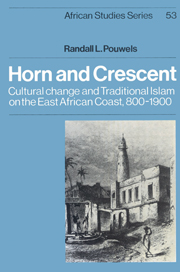Book contents
- Frontmatter
- Contents
- List of illustrations and maps
- Preface
- List of abbreviations
- Introduction
- 1 The roots of a tradition, 800–1500
- 2 The emergence of a tradition, 900–1500
- 3 A northern metamorphosis, 1500–1800
- 4 Town Islam and the umma ideal
- 5 Wealth, piety, justice, and learning
- 6 The Zanzibar Sultanate, 1812–88
- 7 New secularism and bureaucratic centralization
- 8 A new literacy
- 9 The early colonial era, 1885–1914
- 10 Currents of popularism and eddies of reform
- Notes
- Glossary
- Bibliography
- Index
9 - The early colonial era, 1885–1914
Published online by Cambridge University Press: 23 September 2009
- Frontmatter
- Contents
- List of illustrations and maps
- Preface
- List of abbreviations
- Introduction
- 1 The roots of a tradition, 800–1500
- 2 The emergence of a tradition, 900–1500
- 3 A northern metamorphosis, 1500–1800
- 4 Town Islam and the umma ideal
- 5 Wealth, piety, justice, and learning
- 6 The Zanzibar Sultanate, 1812–88
- 7 New secularism and bureaucratic centralization
- 8 A new literacy
- 9 The early colonial era, 1885–1914
- 10 Currents of popularism and eddies of reform
- Notes
- Glossary
- Bibliography
- Index
Summary
It is as difficult in East Africa as it is in other parts of Africa to say exactly when the colonial era began. European influence had been waxing long before 1885. The Sultans of Zanzibar signed successive anti-slave trade treaties with Great Britain in 1828, 1873, and 1876, for example, in addition to treaties of trade and friendship with America (1832), Britain (1839), and France (1844). For decades, these treaties had made European sailors, merchants, and consular officials increasingly familiar sights in coastal towns like Lamu, Mombasa, and Zanzibar. However, 1885 usually is considered to mark the formal onset of the colonial phase in East African history, since it was in 1885 that Kaiser Wilhelm issued the Schutzbrief taking under German protection the territories acquired by Karl Peters through treaties. This single action perhaps more than any other ignited Anglo-German rivalry on the coast and in the interior.
Colonial rule did as much to transform coastal life as anything else in the previous history of the coast. Stated directly, the East African coast was transfigured radically and permanently. Furthermore, the most crucial changes occurred in the initial years of actual colonial rule, 1885–1914. In these three decades, the British managed to affect gravely the relationship of the Sultans to their subjects; to re-create the form and function of the old Sultanate to resemble something more like the European notion of a proper governing institution; and, finally, to alter the essential socio-economic underpinnings of life within the coastal towns.
- Type
- Chapter
- Information
- Horn and CrescentCultural Change and Traditional Islam on the East African Coast, 800–1900, pp. 163 - 190Publisher: Cambridge University PressPrint publication year: 1987

